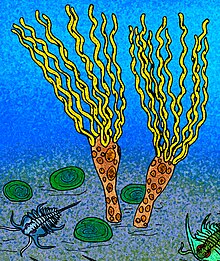103:
138:
532:
117:
306:
and irregularly structured plates. Later forms had a fully developed stalk with regular rows of plates. They were benthic suspension feeders, with five ambulacra on the upper surface, surrounding the mouth and extending into a number of narrow arms. An unusual
Ordovician form was the conical
367:
Rozhnov, S.V. 2009. Eocrinoids and paracrinoids of the Baltic
Ordovician basin: a biogeographical report. IGCP Meeting, Ordovician palaeogeography and palaeoclimate, Copenhagen, p. 16.
259:
that lived between the Early
Cambrian and Late Silurian periods. They are the earliest known group of stalked, arm-bearing echinoderms, and were the most common echinoderms during the
573:
491:
380:
Pander, 1830 (Echinodermata; Ordovician), p. 179-180, in David, B., Guille, A., Féral, J.-P. & Roux, M. (eds.), Echinoderms through time (Balkema, Rotterdam).
393:
627:
352:
406:
612:
566:
333:
Prothero, D.R.,2004, Bringing
Fossils to Life; An Introduction to Paleobiology (2 ed.):New York, The McGraw-Hill companies, p. 324
597:
559:
617:
607:
602:
622:
314:
137:
421:
504:
478:
287:
592:
303:
132:
279:
509:
403:
348:
543:
459:
102:
496:
410:
398:
531:
586:
291:
59:
309:
267:
453:
275:
200:
34:
539:
283:
271:
256:
233:
221:
169:
79:
44:
444:
182:
149:
84:
470:
116:
438:
299:
295:
260:
242:
74:
69:
54:
49:
39:
216:
89:
64:
376:
Rozhnov, S.V. and
Kushlina, V.B. 1994. Interpretation of new data on
347:. Philadelphia, PA: Holt-Saunders International. pp. 1007–1008.
159:
415:
483:
419:
399:
Evolutionary palaeoecology of early epifaunal echinoderms
270:
group that may have been ancestral to six other classes:
547:
428:
232:
208:
131:
23:
110:Eocrinoid holdfasts (Middle Ordovician, Utah)
567:
404:Cambrian explosion with Eocrinoid information
298:, who are believed to be ancestral to modern
8:
574:
560:
416:
294:. They may also be the progenitors of the
115:
101:
20:
236:included but traditionally excluded taxa
326:
7:
528:
526:
313:with its single brachiole. See also
546:. You can help Knowledge (XXG) by
302:. The earliest genera had a short
14:
530:
136:
1:
628:Prehistoric echinoderm stubs
315:List of echinodermata orders
124:Colourful reconstruction of
644:
613:Cambrian first appearances
525:
343:Barnes, Robert D. (1982).
240:
213:
133:Scientific classification
123:
114:
109:
100:
255:are an extinct class of
542:-related article is a
598:Paleozoic echinoderms
505:Paleobiology Database
394:Palaeos on Eocrinoids
618:Silurian extinctions
608:Silurian echinoderms
603:Cambrian echinoderms
345:Invertebrate Zoology
16:Class of echinoderms
623:Paraphyletic groups
409:2006-09-12 at the
266:Eocrinoids were a
555:
554:
538:This prehistoric
520:
519:
422:Taxon identifiers
354:978-0-03-056747-6
249:
248:
204:
95:
30:Cambrian–Silurian
635:
576:
569:
562:
534:
527:
513:
512:
500:
499:
487:
486:
474:
473:
464:
463:
462:
449:
448:
447:
417:
381:
374:
368:
365:
359:
358:
340:
334:
331:
209:Groups included
199:
194:
181:
141:
140:
119:
105:
94:
31:
27:Temporal range:
26:
21:
643:
642:
638:
637:
636:
634:
633:
632:
583:
582:
581:
580:
523:
521:
516:
508:
503:
495:
490:
482:
477:
469:
467:
458:
457:
452:
443:
442:
437:
424:
411:Wayback Machine
390:
385:
384:
375:
371:
366:
362:
355:
342:
341:
337:
332:
328:
323:
198:
192:
179:
135:
96:
93:
92:
87:
82:
77:
72:
67:
62:
57:
52:
47:
42:
37:
29:
28:
17:
12:
11:
5:
641:
639:
631:
630:
625:
620:
615:
610:
605:
600:
595:
585:
584:
579:
578:
571:
564:
556:
553:
552:
535:
518:
517:
515:
514:
501:
488:
475:
465:
450:
434:
432:
426:
425:
420:
414:
413:
401:
396:
389:
388:External links
386:
383:
382:
369:
360:
353:
335:
325:
324:
322:
319:
288:Parablastoidea
247:
246:
238:
237:
230:
229:
228:
227:
224:
219:
211:
210:
206:
205:
190:
186:
185:
177:
173:
172:
167:
163:
162:
157:
153:
152:
147:
143:
142:
129:
128:
121:
120:
112:
111:
107:
106:
98:
97:
88:
83:
78:
73:
68:
63:
58:
53:
48:
43:
38:
33:
32:
25:
15:
13:
10:
9:
6:
4:
3:
2:
640:
629:
626:
624:
621:
619:
616:
614:
611:
609:
606:
604:
601:
599:
596:
594:
591:
590:
588:
577:
572:
570:
565:
563:
558:
557:
551:
549:
545:
541:
536:
533:
529:
524:
511:
506:
502:
498:
493:
489:
485:
480:
476:
472:
466:
461:
455:
451:
446:
440:
436:
435:
433:
431:
427:
423:
418:
412:
408:
405:
402:
400:
397:
395:
392:
391:
387:
379:
373:
370:
364:
361:
356:
350:
346:
339:
336:
330:
327:
320:
318:
316:
312:
311:
305:
301:
297:
293:
292:Paracrinoidea
289:
285:
281:
277:
273:
269:
264:
262:
258:
254:
245:
244:
239:
235:
234:Cladistically
231:
225:
223:
220:
218:
215:
214:
212:
207:
202:
197:
191:
188:
187:
184:
178:
175:
174:
171:
170:Echinodermata
168:
165:
164:
161:
158:
155:
154:
151:
148:
145:
144:
139:
134:
130:
127:
122:
118:
113:
108:
104:
99:
91:
86:
81:
76:
71:
66:
61:
56:
51:
46:
41:
36:
22:
19:
548:expanding it
537:
522:
429:
378:Bolboporites
377:
372:
363:
344:
338:
329:
310:Bolboporites
308:
268:paraphyletic
265:
252:
250:
241:
195:
126:Gogia ojenai
125:
18:
460:Eocrinoidea
454:Wikispecies
430:Eocrinoidea
276:Diploporita
257:echinoderms
253:Eocrinoidea
196:Eocrinoidea
176:Subphylum:
24:Eocrinoidea
587:Categories
540:echinoderm
321:References
284:Blastoidea
280:Coronoidea
272:Rhombifera
222:Rhombifera
593:Blastozoa
243:Blastoids
183:Blastozoa
156:Kingdom:
150:Eukaryota
468:BioLib:
439:Wikidata
407:Archived
304:holdfast
300:crinoids
296:cystoids
261:Cambrian
166:Phylum:
160:Animalia
146:Domain:
484:4717415
445:Q149514
226:others?
217:Gogiida
189:Class:
471:453694
351:
290:, and
203:, 1899
201:Jaekel
510:31058
492:IRMNG
544:stub
497:1168
349:ISBN
251:The
35:PreꞒ
479:EoL
589::
507::
494::
481::
456::
441::
317:.
286:,
282:,
278:,
274:,
263:.
85:Pg
575:e
568:t
561:v
550:.
357:.
193:†
180:†
90:N
80:K
75:J
70:T
65:P
60:C
55:D
50:S
45:O
40:Ꞓ
Text is available under the Creative Commons Attribution-ShareAlike License. Additional terms may apply.



